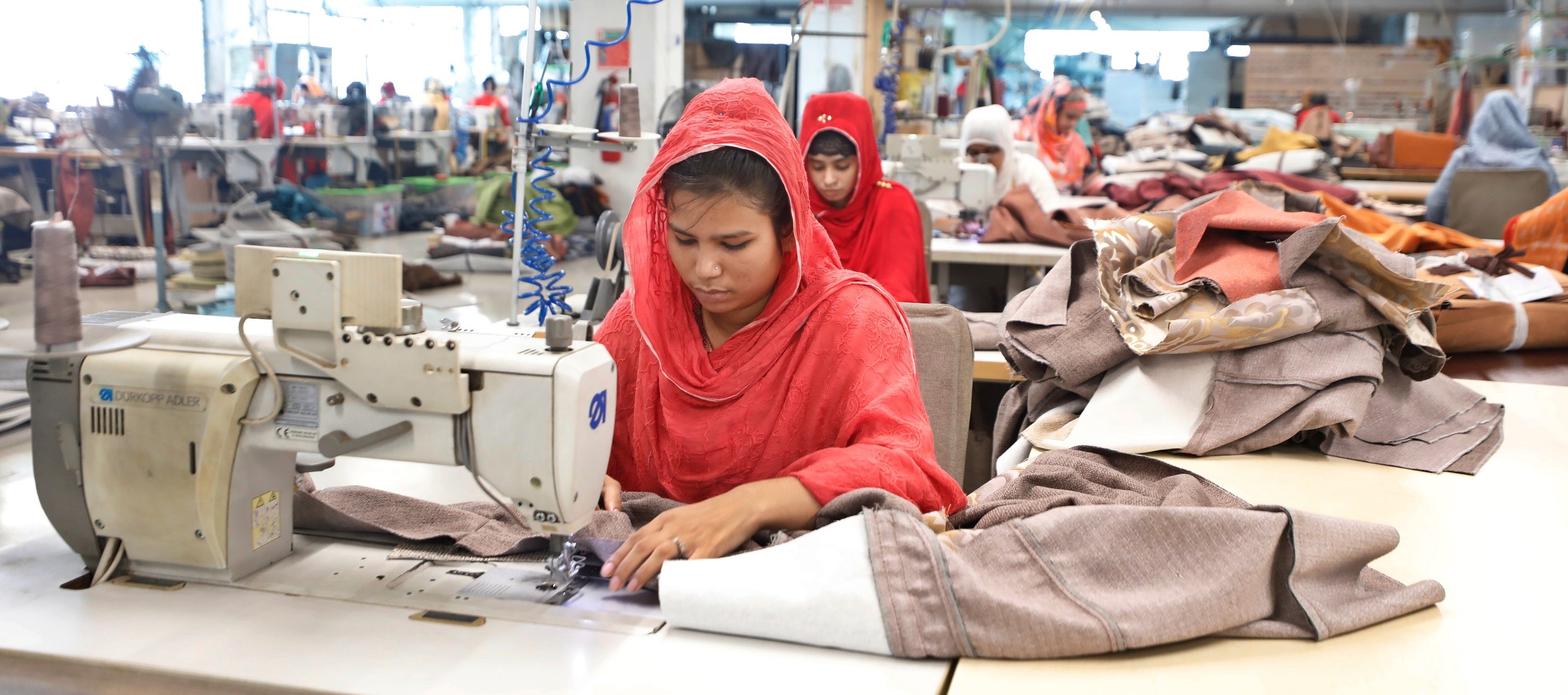 Photo of workers at a factory in Dhaka, Bangladesh. Photo: Sk Hasan Ali/Shutterstock.com
Photo of workers at a factory in Dhaka, Bangladesh. Photo: Sk Hasan Ali/Shutterstock.com
Between 18 to 20 million people join the working-age population in South Asia, every year, but only a third to a half of them will be employed. While the region is now the fastest growing in the world, too few of its people are engaged in or benefit from productive activities. So, what needs to be done?
The first focus should be on women. South Asia’s very low female labor force participation is both a cause and symptom of the jobs deficit. It is a cause because South Asia’s women are not seeking work outside the home; and a symptom because there aren’t enough jobs that will attract them outside the home. Around the world, female labor force participation rates have not moved much, but South Asia is the only region where they have significantly declined. Reversing this trend will require measures to increase job creation rates overall, as well as attention to factors that hold women back from seeking employment and being employed.
Starting with job creation, South Asia has a limited window of opportunity to attract manufacturing jobs with the shift in global value chains – the so-called China + 1 strategy of multinationals - and should grab it. But current policies are too focused on providing subsidies, tax breaks and trade protection to attract manufacturing investment. Such policies may be costly and ineffective unless deeper structural issues that hamper investment are simultaneously addressed. These range from the cost of logistics, the availability of land, credit, and critical imports, to labor market regulations that make it costly to employ formal workers. Bangladesh’s relative success in developing its garments industry, following a period of accelerated economic reforms in the 1990s, provides some encouraging evidence.
While manufacturing offers excellent opportunities for on the job learning and has thus traditionally been the route to improved incomes for workers from rural, agricultural backgrounds, most future jobs will be created in services. The automation of manufacturing processes, East Asia’s dominance in many manufacturing value chains, and the shifting patterns of demand create an environment that favors service jobs. Policies to boost employment thus need to be broader than the current focus on manufacturing.
Organized retail, tourism and logistics, for example, are key sectors that could generate the jobs of the future. Developing health services, enabled by digital technologies, could be another win-win for South Asia, in particular for women, as demand is rising fast. The transition to high value regenerative agriculture may offer additional opportunities for income gains and job creation on and off the farm. Bhutan and Nepal can benefit from development of their hydro potential and associated industries and services.
Harnessing job opportunities in all sectors has implications for policies. In much of South Asia, complicated regulations, often designed to protect the poor and small firms, have the unintended consequence of discouraging hiring of workers and expansion by firms. A regular dialogue with the private sector can help identify key sector specific constraints. Moreover, distortions in capital and land markets favor bigger businesses and more capital-intensive investments and lead to much entrepreneurial talent remaining underutilized. The voice of small and informal businesses thus needs to be heard for employment policies to be fully effective.
To ensure women benefit from these new opportunities, barriers that keep women from looking for a job or that make it especially challenging for women to remain in work, will also need to be lowered. Keeping girls in school provides the foundation. But experience throughout South Asia shows that measures such as safe transport, harassment-free workplaces, and childcare can also play an important role. Besides, the Rana Plaza tragedy in Bangladesh is a reminder of the importance of ensuring that labor’s voice is heard.
One approach to change this is to use the concept of a Jobs Platform. Recognizing that job creation will require different responses in the varied South Asian countries, and in some cases within the countries, a jobs platform is a framework that covers the many issues that can affect job creation, while recognizing that progress can be made without needing to tackle all issues at once in every context. A focus on jobs-rich sectors helps define the scope of the challenge and identify the most immediate priorities. A focus on implementation will move stakeholders from plans to action. And a focus on monitoring will help ensure accountability for results.
This blog is part of a series that explores examples of policies, investments, and partnerships that are delivering results and that could be scaled to match the ambition of the World Bank's new playbook for South Asia.




Join the Conversation